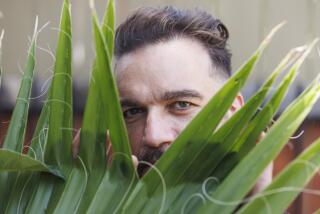Florida Community Turns Garbage-Strewn Dump Into Art-Studded Beauty Spot
- Share via
BOYNTON BEACH, Fla. — The six yellow front-end loaders serve a loftier purpose these days. Rusting in a parking lot, scavenged for spare parts, they hold colorful paintings in their scoops instead of dirt.
Nearby, an urban roadside once littered with mounds of trash is lined with metal sculptures and other rustic art such as marble totem poles and Picasso-like paintings by neighborhood children.
Ray Marcinkoski, grading-company owner and unlikely patron of the arts, has helped transform this industrial area into an artsy landscape.
“There was old cars, refrigerators--you name it. Just imagine 600 yards of junk,” said the gruff, tough-looking Marcinkoski.
Two years ago he got sick of the trash and decided to do something about it. He made a deal with the City of Boynton Beach: If they supplied trash bins, he would clean up West Industrial Avenue.
“It’s a do-as-you-get-to-it project, and it’s getting better and better,” he said.
Marcinkoski pushed around sand and dirt by the road to create a bank, then built a wooden fence as a backdrop and hauled in huge chunks of coral for decoration. Now he brings in trees and plants he finds discarded on job sites, nurturing them to health on the bank alongside purchased flowers.
Meanwhile, sculptor Richard W. Beau Lieu has turned his landlord’s vision into a mission.
Marcinkoski asked Beau Lieu, owner of the Neighborhood Gallery next door to Marcinkoski’s shop, if he could help in the beautification effort. So Beau Lieu persuaded artists to create and donate metal sculptures and paintings on burlap and canvas for a street-side garden gallery in progress.
The result is not the usual lush Florida garden.
The rocky, desert-like landscape exudes a man’s touch. The 60 pieces along the street include chrome-bumper art in the shape of a cactus, a purple metal unicycle tucked between two scruffy trees and Jackson Pollock-style paintings by local artist Helen Kelsey.
The wildflowers growing among the sculptures and paintings excite Beau Lieu the most.
“You can see what nature is doing,” Beau Lieu said as he pointed at a black metal sculpture tangled with wild red-and-white bleeding heart. Hot-pink bougainvillea peeked over the wooden fence behind it. “That’s the thing about art outdoors. It’s always changing.”
At night, the once dark and foreboding street is now flooded with lights directed at the sculptures and paintings. People stroll by, viewing the art, as late as 1 a.m.
The gallery, its entrance marked by a 10-foot metal post enjoying a new life as a birthday candle, has created a sense of community.
A woman living nearby pulls her hose around the fence to water plants on hot summer days. Primitive paintings on plywood, created by underprivileged children during a grant-funded workshop sponsored by Beau Lieu, form a makeshift basketball goal outside his studio doors. Workers in the warehouses nearby know they can always find a basketball under the lid of the same garbage can.
“The overall benefit is all of the neighbors have joined in,” said a sculptor who goes only by the name Dextr. He has a nearby studio and has donated some of his own works.
“People come by and say, ‘Hey, I’ve got 100 plants,’ or bring money to help out. This place was filled with rubbish. Now you hardly see a bottle on the side of the road.”
More to Read
Sign up for Essential California
The most important California stories and recommendations in your inbox every morning.
You may occasionally receive promotional content from the Los Angeles Times.













